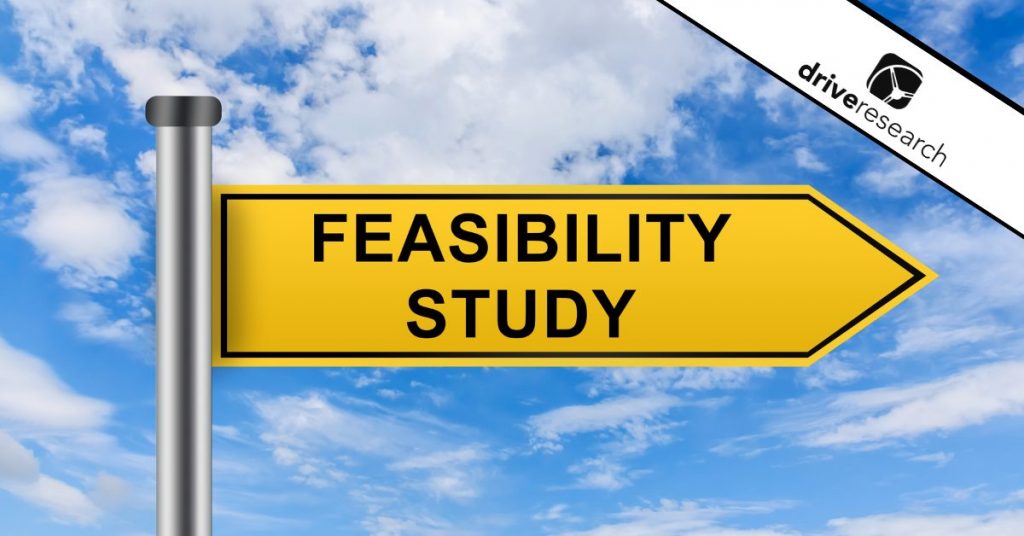
Feasibility studies come in all shapes and sizes. They can be completed for a new product, new service, new concept, or new location. In many cases it combines both primary and secondary data together to provide the sponsoring client answers.
What is a Feasibility Study?
A feasibility study is a type of market research which analyzes the success or failure of a new product, service, concept, or location. It uses several components of market research including both primary and secondary data to analyze and predict the outcome of the new concept.
Feasibility studies are often completed for:
- New product development
- New service launches
- New business concepts
- New business locations or an expansion to a new market
Commercial lenders often require a feasibility study to acquire financing for a concept. The intent of the feasibility study is to eliminate the risk and chance of failure in the investment. Drive Research partners with banks and credit unions to complete these feasibility studies to address this.
Need a feasibility study? Here is the process, components, and benefits of working with a feasibility study company.
What is the 7-Step Process for a Feasibility Study?
Our feasibility studies are built on a task-oriented step-by-step approach. We follow an exclusive roadmap to successful market research from start-to-finish with our clients. Drive Research works as a true consultant to analyze the market, understand the competition, and make estimates around interest, appeal, and demand of users.
The final report explains the potential successes and barriers of a new product, service, or location coming to market through an independent and objective lens. Recommendations to increase appeal and demand are also included in the report. These assist with improving operations, marketing, and strategy around the new concept.
Here are the 7 steps:
- Full proposal
- Kickoff meeting
- Workplan
- Setup and design
- Fieldwork
- Comprehensive report
- Debrief
What are the 3 Core Components of a Feasibility Study?
Component 1: Demographic and Trends Analysis
Our team analyzes demographic trends of populations, age, genders, incomes, household sizes, consumer expenditures, and other vital data from our proprietary software. A market area can be pinpointed to a radius around a site, counties, and even Census Tracts. This helps a client understand potential size and profiles a pool of audiences to attract.
Component 2: Competitive Assessment
This is a comprehensive overview of up to 5 key competitors in the market. It reviews their strengths, weaknesses, service offerings, products, differentiators, and other factors that would impact the success or failure of a new market entrant.
Component 3: Market Survey
This is an online survey targeted to current and potential users or visitors to the location. This includes 15 questions and lasts 3 to 5 minutes. The survey will cover interest in the location, appeal, likelihood to use, demand, and other key objectives which will impact the feasibility of the concept.
How Much Does a Feasibility Study Cost?
This depends on a number of factors including which components are chosen, the scope, and the timeline. A feasibility study company will work with your organization to create a scope which meets the needs of your budget. Most feasibility studies fall in the $5,000 to $15,000 range, however this is highly dependent on your type of business and your needs. The fees may vary (less or more).
Why Work With Drive Research For Feasibility Studies?
Responsiveness
We eat, sleep, and live market research. To accelerate insights, we prioritize communication. Our team follows-up with clients immediately, pushes the status quo for turn-around time, and creates a new definition for fast. We put in the extra time that other market research firms do not (because we enjoy it).
Growth
We invest in our employees, our company, our culture, our clients, and the community. We want our staff to grow personally and professionally while also helping our clients’ organizations grow. Our give-back program donates a portion of revenues for each project, which also helps grow our community. Everybody wins.
Perspective
Market research focuses on others’ perspectives, opinions, and beliefs. We employ the same strategy with our market research clients. We center our entire business model around you. We walk in your shoes from research design to analysis, through recommendations. We answer your questions before you ask.
Drive
After all, it is our name. Drive Research is more than just data-driven strategies. Drive relates to our passion for our work, flexibility in our work environment and with client projects, and the impact and ROI our market research generates. We ask more from our market research, you should too. We believe in better.
Contact Our Feasibility Study Company
Drive Research is a market research agency. We work with a variety of clients and industries across the country to assist with both qualitative and quantitative market research needs.
Contact us below.



